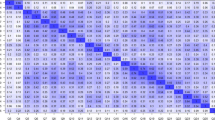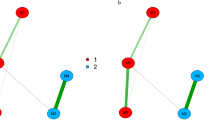Abstract
In spite of the potential significance of sense of coherence (SOC) for adolescent health and well-being, the past decades have yielded limited progress in investigating the psychometric properties of the most used inventory measuring SOC, The Orientation of Life Questionnaire (OLQ) in adolescents. The present study aimed at investigating the factorial validity and reliability of the Norwegian version of the 13 item OLQ based on two adolescent samples 13–18 years from Norway. Concerning the dimensionality of the OLQ, two measurement models were tested using confirmatory factor analysis; a one-factor model and a three-factor-model. The results showed that a three-factor solution with correlated residual variances between item 2 and item 3 showed the best fit across the two adolescent samples, although five items revealed low factor loadings. The dimensions were highly correlated and showed adequate composite reliability. The present results indicate that the 13 item OLQ has potential as an instrument assessing SOC in adolescents. However, more psychometric testing of the instrument is required in reference to the modified factor structure and the low reliability found on some of the items in OLQ.

Similar content being viewed by others
References
Antonovsky, A. (1979). Health, stress and coping. San Francisco: Jossey-Bass.
Antonovsky, A. (1987). Unraveling the mystery of health. How people manage stress and stay well. San Fransisco: Jossey-Bass.
Antonovsky, A. (1993). The structure and properties of the sense of coherence scale. Social Science and Medicine, 36, 969–981.
Bagozzi, R. P., & Yi, Y. (1988). On the evaluation of structural equation models. Journal of the Academy of Marketing Science, 16, 74–94.
Bollen, K. A. (1989). Structural equations with latent variables. New York: John Wiley & Sons.
Braun- Lewensohn, O., & Sagy, S. (2010). Sense of coherence, hope and values among adolescents under missile attacks: A longitudinal study. International Journal of Children’s Spirituality, 15, 247–260.
Brown, T. A. (2006). Confirmatory factor analysis for applied research. London: The Guildford Press.
Byrne, M.B. (2001). Structural Equation Modeling with AMOS. Basic concepts, applications, and programming. USA: Taylor AND Francis Group.
Derdikman-Eiron, R., Indredavik, M. S., Bratberg, G. H., Taraldsen, G., Bakken, I. J., & Colton, M. (2011). Gender differences in subjective well-being, self-esteem and psychosocial functioning in adolescents symptoms of anxiety and depression: Findings from the Nord-Trøndelag health study. Scandinavian Journal of Psychology, 52, 261–267.
Ding, Y., Bao, L., Xu, H., & Hallberg, I. R. (2011). Psychometric properties of the Chinese version of sense of coherence scale in women with cervical cancer. Psycho-Oncology, 21, 1205–1214.
Eriksson, M. (2007). Unravelling the mystery of salutogenesis. The evidence base of the salutogenic research as measured by Antonovsky’s Sense of Coherence Scale. (Research Report No. 1). Turku: Folkhälsan Research Centre, Health promotion research programme.
Eriksson, M., & Lindström, B. (2005). Validity of Antonovsky’s sense of coherence scale: A systematic review. Journal of Epidemiology and Community Health, 59, 460–466.
Eriksson, M., & Lindström, B. (2006). Antonovsky’s sense of coherence scale and the relation with health: A systematic review. Journal of Epidemiology and Community Health, 60, 376–381.
Feldt, T., Lintula, H., Suominen, S., & Koskenuvo, M. (2007). Structural validity and temporal stability of the 13-item sense of coherence scale: Prospective evidence from the population-based HeSSup study. Quality of Life Research, 16, 483–493.
Gana, K., & Garnier, S. (2001). Latent structure of the sense of coherence scale in a french sample. Personality and Individual Differences, 31, 1079–1090.
Hagquist, C., & Andrich, D. (2004). Is the sense of coherence-instrument applicable on adolescents? A latent trait analysis using Rasch-modelling. Personality and Individual Differences, 36, 955–968.
Hair, J., Black, W., Babin, B., & Anderson, R. (2010). Multivariate data analysis: Upper Saddle River: Prentice Hall.
Hittner, J. B. (2007). Factorial invariance of the 13-item sense of coherence scale across gender. Journal of Health Psychology, 12, 273–280.
Hu, L., & Bentler, P. (1998). Fit Indices in covariance structure modelling: Sensitivity to underparametrized model misspecification. Psychological Methods, 3, 424–453.
Lindström, B., & Eriksson, M. (2010). The Hitchhiker`s guide to salutogenesis. Salutogenic pathways to health promotion. (Research Report No. 2) Helsinki: Folkhälsan Research Centre, Health promotion research programme.
Moksnes, U. K., Löhre, A., & Espnes, G. A. (2012). The association between sense of coherence and life satisfaction in adolescents. Quality of Life Research, 22, 1331–1338.
Naaldenberg, J., Tobi, H., van den Esker, F., & Vaandrager, L. (2011). Psychometric properties of the OLQ-13 scale to measure Sense of Coherence in a community-dwelling older population. Health and Quality of Life Outcomes, 9, 37–46.
Neuner, B., Busch, M. A., Singer, S., Moons, P., Wellmann, J., Bauer, U., et al. (2011). Sense of Coherence as a predictor of quality of life in adolescents with congenital heart defects: A register-based 1-year follow-up study. Journal of Developmental and Behavioral Pediatrics, 32, 316–327.
Nielsen, A. M., & Hansson, K. (2007). Associations between adolescents’ health, stress and sense of coherence. Stress and Health, 23, 331–341.
Nilsson, K. W., Leppert, J., Simonsson, B., & Starrin, B. (2010). Sense of coherence and psychological well-being: Improvements with age. Journal of Epidemiological and Community Health, 64, 347–352.
Öztekin, O., & Tezer, E. (2009). The role of sense of coherence and physical activity in positive and negative affect of Turkish adolescents. Adolescence, 44, 421–431.
Raykov, T. (2001). Estimation of congeneric scale reliability using covariance structure analysis with nonlinear constraints. British Journal of Mathematical and Statistical Psychology, 54, 315–323.
Richardson, C. G., Ratner, P. A., & Zumbo, B. D. (2007). A test of the age-based measurement invariance and temporal stability of Antonovsky’s sense of coherence scale. Education and Psychological Measurement, 67, 679–696.
Rivera, F., Garcia-Moya, I., Moreno, C., & Ramos, P. (2012). Developmental contexts and sense of coherence in adolescence: A systematic review. Journal of Health Psychology, 18, 800–812.
Schermelleh-Engel, K., Moosbrugger, H., & Muller, H. (2003). Evaluating the fit of structural equation models: Tests of significance and descriptive goodness-of-fit measures. Methods of Psychological Research, 8, 23–74.
Simonsson, B., Nilsson, K. W., Leppert, J., Vinod, K., & Diwan, V. K. (2008). Psychosomatic complaints and sense of coherence among adolescents in a county in Sweden: A cross-sectional school survey. BioPsychoSocial Medicine, 2, 1–8.
Author information
Authors and Affiliations
Corresponding author
Rights and permissions
About this article
Cite this article
Moksnes, U.K., Haugan, G. Validation of the Orientation to Life Questionnaire in Norwegian Adolescents, Construct Validity Across Samples. Soc Indic Res 119, 1105–1120 (2014). https://doi.org/10.1007/s11205-013-0536-z
Accepted:
Published:
Issue Date:
DOI: https://doi.org/10.1007/s11205-013-0536-z




